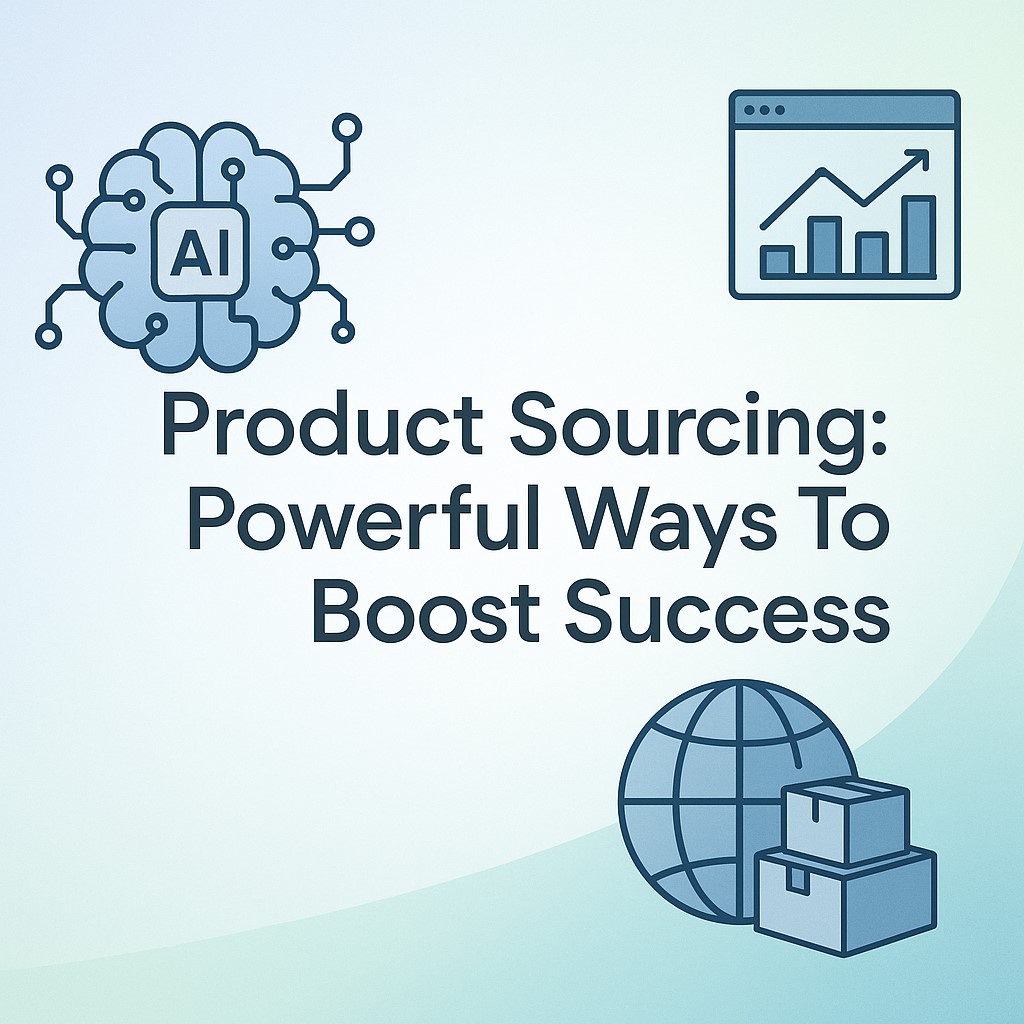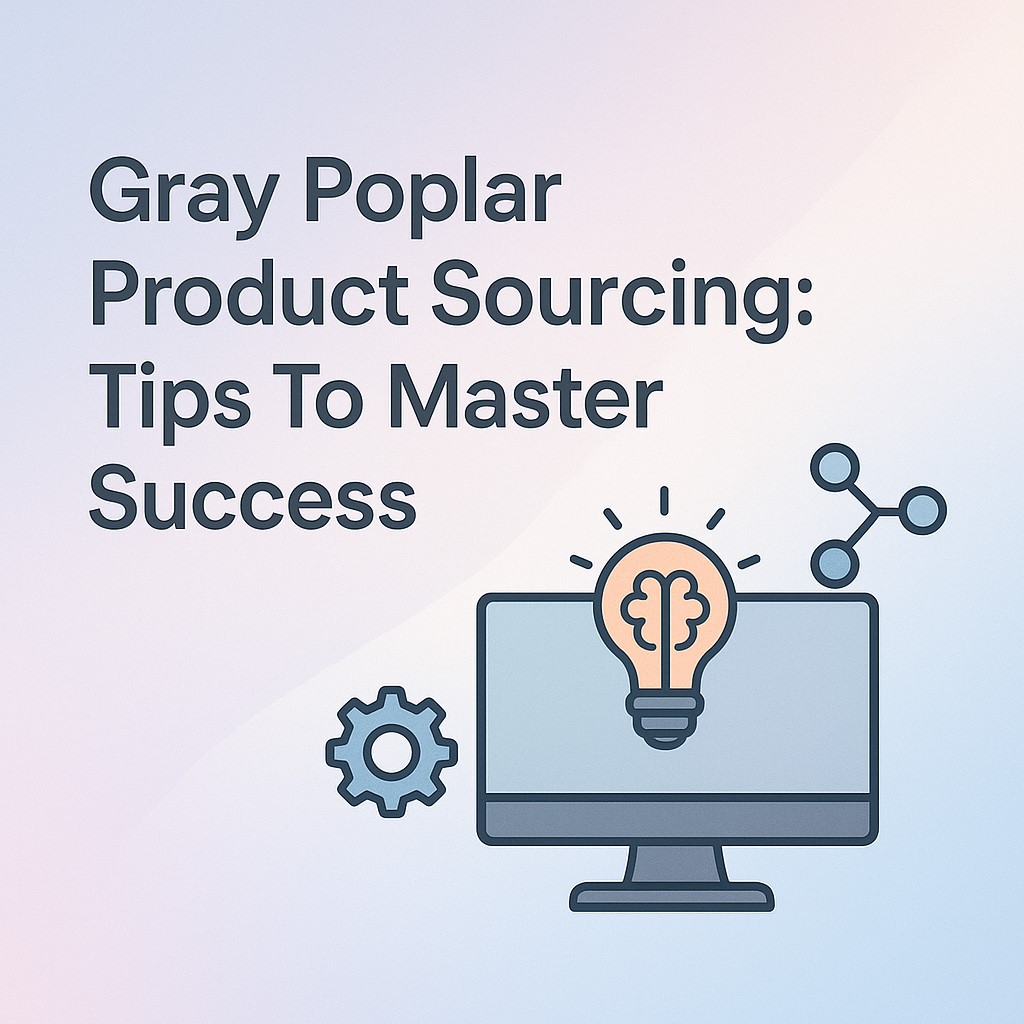Ready to launch your shop? Learn how E-commerce product sourcing helps you find the best products to sell and keeps your customers coming back.
E-commerce product sourcing is all about finding the right products to sell in your online store. It’s the first big step before you can start making sales and growing your brand. Without good sourcing, even the best marketing won’t help you succeed.
When you dive into e-commerce product sourcing, you’re choosing what you want your shop to be known for. It’s more than just picking random items. You need to think about what people want, how much they’ll pay, and where you can get it at a good price. This helps you stand out and build trust with your customers.
E-commerce product sourcing also matters because it controls your costs and profit. By finding reliable suppliers and quality products, you avoid problems like late shipping, bad reviews, or lost money. In short, smart e-commerce product sourcing sets you up for long-term success and gives your store the best chance to grow.
Table of contents
- How to find reliable e-commerce product sourcing suppliers?
- E-commerce product sourcing supplier verification tips
- Vetting manufacturers for e-commerce product sourcing
- E-commerce product sourcing negotiation strategies
- E-commerce product sourcing automation software guide
- Machine learning in e-commerce product sourcing
- Predictive analytics for e-commerce product sourcing
- Best AI solutions for e-commerce product sourcing
- E-commerce product sourcing market analysis tips
- Profit calculator for e-commerce product sourcing
- Demand forecasting for e-commerce product sourcing
- Best apps for e-commerce product sourcing sellers
- Alibaba alternatives for e-commerce product sourcing
- FAQs: E-commerce product sourcing
- Conclusion
How to find reliable e-commerce product sourcing suppliers?
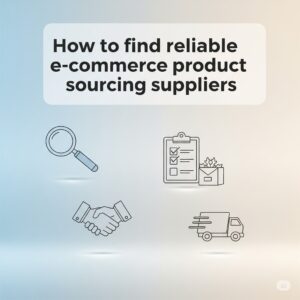
Easy steps to pick suppliers you can trust. Finding good suppliers is one of the most important parts of e-commerce product sourcing. It can be tricky at first, but with a few smart steps, you’ll feel confident choosing the right partner. Let’s look at how you can do it without stress.
Research your supplier options
Start with trusted sourcing platforms. Sites like Alibaba, Global Sources, and ThomasNet list verified suppliers. Check their ratings, reviews, and business licenses. When doing e-commerce product sourcing, make sure your supplier is legit before you even start talking about prices.
Ask questions and request samples
Good suppliers answer your questions clearly. Ask about production times, minimum order quantities, and shipping options. Don’t skip getting samples. This lets you see the quality yourself. Smart e-commerce product sourcing always includes testing products before placing a big order.
Look for clear communication
A reliable supplier responds quickly and gives you honest details. If someone avoids your questions or is slow to reply, that’s a red flag. You want a partner who makes e-commerce product sourcing easier, not harder. Good communication means fewer surprises and better results.
Finding the right supplier takes time. Be patient, ask the right questions, and don’t rush your decision. When you pick carefully, you set yourself up for smoother business and happier customers.
E-commerce product sourcing supplier verification tips
Simple ways to make sure your supplier is legit. Verifying your suppliers is super important in e-commerce product sourcing. It saves you from scams, poor-quality products, and wasting your money. Let’s go through some easy, practical tips to help you choose suppliers you can actually trust.
Check their business details
First, ask for their business license or any certifications they have. A real supplier won’t mind sharing this. It shows they’re serious and professional. This step in e-commerce product sourcing helps you avoid anyone shady who might just take your money and vanish.
Read reviews and talk to past buyers
Look at reviews on sourcing websites. See what other people say about their products and service. Don’t stop there. Ask the supplier for references. A good supplier will gladly connect you with other buyers. This builds trust and gives you peace of mind during e-commerce product sourcing.
Always test with samples first
Never skip getting a sample. It’s the best way to see what you’re actually buying. Check the quality, packaging, and any custom touches. If a supplier refuses to send a sample, that’s a warning sign. Smart e-commerce product sourcing always includes testing before you spend big.
Checking your suppliers might take extra time, but it’s worth it. It keeps your business safe and helps you work with people who deliver what they promise. Stay curious, ask questions, and don’t rush—it’ll make your e-commerce journey so much smoother.
Vetting manufacturers for e-commerce product sourcing
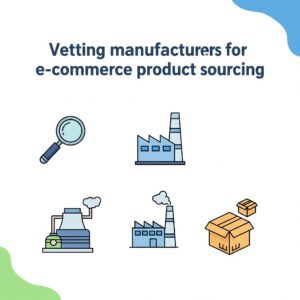
How to choose the right partners for your store? Finding the right manufacturer is a big part of e-commerce product sourcing. You want someone reliable who delivers quality every time. Let’s look at some easy steps to help you pick the right manufacturer without getting overwhelmed.
Research their background carefully
Start by checking their history. Look at how long they’ve been in business and what products they specialize in. A solid track record means they know what they’re doing. When you’re working on e-commerce product, picking an experienced manufacturer can save you from a lot of headaches later.
Ask detailed questions E-commerce product sourcing
Don’t be afraid to ask questions. What are their minimum order quantities? How long does production take? Can they handle custom packaging or branding? Good manufacturers will answer clearly and honestly. This step in e-commerce product sourcing shows you’re serious and helps you avoid surprises down the line.
Test quality with samples
Always order samples before making big commitments. Check the materials, finish, and packaging. Make sure it matches what you want to sell. If the sample isn’t good enough, keep looking. Smart e-commerce product sourcing always includes testing so you know exactly what your customers will get.
Choosing the right manufacturer takes time, but it’s worth it. Be patient, do your research, and ask smart questions. It sets you up for success and keeps your customers happy with every order.
E-commerce product sourcing negotiation strategies
Easy ways to get better deals with suppliers. Negotiating is a big part of e-commerce product. It’s not just about lowering prices. It’s about making sure both you and your supplier are happy with the deal. Let’s look at simple strategies you can use to negotiate confidently and fairly.
Be clear about what you want
Know exactly what you need before you start talking. Share details like order size, quality standards, and delivery times. This makes you look professional. When you’re clear, suppliers trust you more, which is key in e-commerce product sourcing.
Build a friendly relationship E-commerce product sourcing
Negotiation isn’t a fight. Be polite and respectful. Ask questions about their process. Show interest in their challenges. When suppliers see you as a partner, they’re more willing to offer better prices or flexible terms. Good relationships make e-commerce product much smoother.
Look beyond just the price
Price matters, but it’s not the only thing to discuss. Ask about payment terms, shipping options, and possible discounts for larger orders. Sometimes you can get better value without pushing for the lowest price. This approach to e-commerce product sourcing helps you get deals that actually work for your business.
Negotiation can feel intimidating at first, but it gets easier with practice. Be honest, patient, and prepared. These strategies help you find deals that support your business while keeping your supplier relationships strong and reliable.
E-commerce product sourcing automation software guide
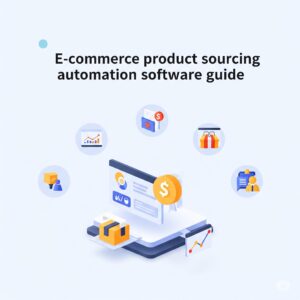
Speed up your sourcing with smart tools. Manual work can slow you down. That’s where automation helps. With the right software, e-commerce product sourcing becomes faster, smoother, and way less stressful. Let’s look at how these tools work and which ones are worth trying.
What does automation software do?
Automation software helps you manage repetitive tasks. It can track product trends, compare supplier prices, and even place sample orders. For e-commerce product this means less guesswork and more data-backed decisions. You get more done in less time without feeling overwhelmed.
Top tools to check out
- Jungle Scout: Great for tracking product trends and analyzing demand.
- Zik Analytics: Best for eBay and cross-platform sourcing insights.
- DSers: Works well with AliExpress for fast product importing and order automation.
- Shopify’s Oberlo (when active): Helps you find products and connect with suppliers easily.
These tools simplify your daily tasks, especially when you’re just starting out in e-commerce product sourcing. Most offer free trials, so you can test them before spending money.
Why automation matters?
Using automation lets you focus on bigger things—like branding, marketing, and customer support. You’ll reduce mistakes, save hours each week, and grow faster. In e-commerce product sourcing, speed and accuracy give you an edge over the competition.
Start with one tool and learn how it works. As you grow, you can explore more features and platforms. Automation isn’t about doing less—it’s about doing it smarter.
Machine learning in e-commerce product sourcing
How smart algorithms help you make better sourcing choices. Machine learning is changing the way we do e-commerce product sourcing. It helps you find the right products, predict trends, and make faster decisions using data—not just guesswork. Let’s break it down in a simple way.
What is machine learning in sourcing?
Machine learning is a type of AI that learns from patterns. In e-commerce product sourcing, it studies product data, customer behavior, and sales history to spot what’s working—and what’s not. This helps you choose better products without spending hours on research.
How it helps online sellers
With machine learning, tools can tell you what products are rising in demand, when to reorder, or which supplier offers the best deal. It’s like having a smart assistant that learns from everything happening in the market. This gives you a big edge in e-commerce product, especially if you’re new.
Tools that use machine learning E-commerce product sourcing
Some popular sourcing tools already use machine learning.
- Helium 10: Predicts trends and helps with keyword research.
- Algopix: Analyzes product demand and pricing across platforms.
- ZonGuru: Offers AI-driven insights for product choices.
These tools make e-commerce product sourcing more accurate and less stressful. You can find winning products faster and make smarter choices with less risk.
Machine learning may sound technical, but you don’t need to be a coder to use it. The tools do the hard work—you just read the results and act. It’s like using a cheat code for sourcing smarter, not harder.
Predictive analytics for e-commerce product sourcing
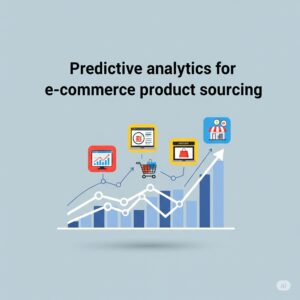
Use data to choose the right products before anyone else. Predictive analytics is like having a crystal ball for e-commerce product. It uses past data to guess what customers will want next. Instead of guessing, you can make smarter choices and stay ahead of your competition.
What is predictive analytics?
Predictive analytics looks at trends, sales history, and customer behavior. It finds patterns in the data. For e-commerce product sourcing, it can tell you what products might become popular or when demand will rise. This helps you stock the right items at the right time.
Benefits for online sellers
With predictive analytics, you waste less money on products that won’t sell. You avoid running out of stock when demand spikes. It also helps you plan better with suppliers. When you’re doing e-commerce product sourcing, this kind of planning can save you stress and keep customers happy.
Tools to try
Some tools already use predictive analytics to make sourcing easier.
- Jungle Scout: Shows demand trends for Amazon products.
- Helium 10: Offers forecasting and keyword research.
- Algopix: Gives pricing and demand predictions for multiple marketplaces.
Using predictive analytics makes e-commerce product sourcing more scientific. You’re not just guessing what might sell—you’re making decisions based on real data. This gives you a big advantage, especially if you’re new and want to reduce risk.
By using these tools and insights, you can choose products with confidence and build a store that’s ready for what buyers want next.
Best AI solutions for e-commerce product sourcing
Smart tools to make sourcing easier and faster. AI is changing how we handle e-commerce product sourcing. Instead of guessing or spending hours on research, you can use AI tools to find winning products, compare suppliers, and plan smarter. Let’s look at some of the best AI solutions you can try right now.
Product research made easy
AI tools help you find products people actually want. Platforms like Helium 10 and Jungle Scout analyze sales data, trends, and competition. For e-commerce product sourcing, this means you can spot high-demand items before everyone else. It saves time and helps you pick products that sell.
Supplier discovery and negotiation
AI doesn’t just help with products. Tools like Alibaba’s Smart Assistant use AI to match you with reliable suppliers. Some platforms even suggest the best times to negotiate or reorder. When you use these for e-commerce product sourcing, you avoid bad suppliers and get better deals without endless back-and-forth.
Demand forecasting and planning
Predictive AI tools like Algopix and ZonGuru forecast demand and suggest pricing. This helps you avoid overstock or selling out too soon. In e-commerce product sourcing, knowing what buyers want next month helps you plan better and keep customers happy.
AI might sound complicated, but these tools are easy to use—even if you’re new. They handle the hard work so you can focus on selling. With the right AI solutions, you’ll feel more confident and ready to grow your store.
E-commerce product sourcing market analysis tips
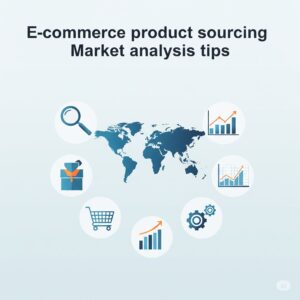
Learn how to study the market before you buy. Market analysis is a must for e-commerce product sourcing. It helps you know what people want, what’s trending, and where there’s too much competition. Doing this right saves you money and helps you pick products that actually sell.
Research demand and trends
Start by checking demand for your product ideas. Use tools like Google Trends or marketplace data to see if people are searching for it. For e-commerce product sourcing, this step shows if there’s real interest or if you’re chasing a dead end.
Study your competition
Look at who’s already selling what you want to source. Check their prices, reviews, and how they market their products. This helps you find gaps you can fill or avoid overcrowded markets. In e-commerce product, knowing your competitors helps you plan your strategy.
Analyze pricing and costs
Don’t just guess the selling price. Factor in sourcing costs, shipping, fees, and marketing. Use calculators or spreadsheets to see if you can make a profit. This careful approach to e-commerce product sourcing keeps you from choosing products that look good at first but lose money in the end.
Market analysis might seem like extra work, but it’s worth it. When you research before buying, you avoid costly mistakes and set yourself up for success. Take your time, use the right tools, and make sure every product you choose has a real chance to sell.
Profit calculator for e-commerce product sourcing
Know your real profits before you buy. Using a profit calculator is a smart move in e-commerce product sourcing. It helps you see if a product is really worth selling. You don’t want to find out too late that fees and shipping costs eat up your profits. Let’s look at how to use these calculators to make better choices.
Enter all your costs
A good profit calculator asks for everything. Add product cost, shipping, packaging, platform fees, and advertising. This step in e-commerce product shows your true expenses. It’s easy to forget small costs, but they add up fast.
Check selling price and margin
Enter your planned selling price. The calculator shows your profit per sale and your margin as a percentage. This is super helpful for e-commerce product sourcing because you can test different prices. You’ll see if you can stay competitive while still making money.
Plan for scale and repeat orders
Don’t just look at one sale. Think about bulk orders and repeat customers. Profit calculators can help you plan for bigger volumes. In e-commerce product, understanding these numbers helps you negotiate better deals with suppliers and avoid surprises.
Using a profit calculator isn’t complicated. Most tools are free or cheap online. They give you clear answers so you can make smarter, more confident choices about what to sell. This simple step can save you from choosing products that look great but don’t actually make you money.
Demand forecasting for e-commerce product sourcing

Plan your inventory with confidence. Demand forecasting is a key part of e-commerce product sourcing. It helps you guess how much stock you’ll need so you don’t run out or overstock. This planning keeps customers happy and saves you money. Let’s look at how to do it simply and effectively.
Look at past sales data
If you’ve sold before, start with your own sales history. Check which months were busy and which were slow. This is a smart move in e-commerce product sourcing because it shows clear patterns you can plan around. Even new sellers can look at industry trends to get an idea.
Use forecasting tools
Many tools help predict demand. Platforms like Jungle Scout or Helium 10 offer sales estimates for products. These tools make e-commerce product easier by giving you real data instead of just guessing. You’ll know when to order more and avoid missing sales during peak times.
Talk to suppliers about lead times
Suppliers need time to produce and ship your products. Always ask how long it takes. Factor this into your forecasting. Good e-commerce product sourcing means you plan ahead, so you’re never left with empty shelves when customers are ready to buy.
Demand forecasting might sound fancy, but it’s just smart planning. Take the time to check data, use simple tools, and stay in touch with your suppliers. This way, you’ll always have the right products ready when customers want them.
Best apps for e-commerce product sourcing sellers
Tools to make sourcing easy and stress-free. Using the right apps can level up your e-commerce product sourcing game. They save you time, help you find products faster, and make managing suppliers simpler. Let’s check out some of the best apps you can start using right now.
Alibaba and AliExpress apps
These are classics for a reason. Both apps help you find suppliers and products quickly. You can chat directly with sellers, compare prices, and even order samples. For e-commerce product, these apps are must-haves when you’re just starting out.
Jungle Scout and Helium 10
These apps are perfect for product research. They show sales trends, demand estimates, and keyword data. With these tools, e-commerce product sourcing becomes less about guessing and more about knowing what will actually sell. They also help you avoid oversaturated markets.
Oberlo and DSers
If you’re into dropshipping, these apps make everything smooth. They help you import products into your store with one click and automate orders. It’s a big help in e-commerce product because you don’t have to hold any inventory yourself.
Using these apps doesn’t just make you faster—it makes you smarter. They help you research better, avoid mistakes, and grow your store with confidence. Try a few, see what works best for you, and keep learning as you go.
Alibaba alternatives for e-commerce product sourcing
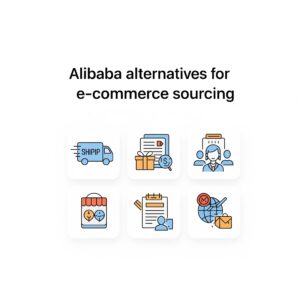
Check out these other places to find great suppliers. Alibaba is popular, but it’s not the only game in town. Lots of sellers are exploring other sites for e-commerce product sourcing. These alternatives can help you find unique products, better deals, or even faster shipping. Let’s look at some you might want to try.
1. Global Sources
Think of Global Sources as Alibaba’s serious sibling. It’s full of verified suppliers, mostly in Asia. You’ll find factories ready to work with you on samples or big orders. If you want to get professional about e-commerce product, this is a smart choice. It even has trade show access if you’re feeling fancy.
2. IndiaMART
Want something different from the usual? IndiaMART is perfect for unique or handmade products from India. You can find all kinds of cool stuff—from clothes to eco-friendly goods. It’s great for e-commerce product sourcing if you want your store to stand out with products not everyone is selling.
3. Thomasnet
If you want to keep things closer to home, check out Thomasnet. It connects you with suppliers in the U.S. That means faster shipping and sometimes higher quality. For students in the U.S., it’s a solid e-commerce product sourcing option because you can cut down on delivery times and support local makers.
Exploring these alternatives gives you more choices. Whether you want better prices, unique products, or quicker shipping, don’t be afraid to look beyond Alibaba. Always compare suppliers and ask for samples before you buy big. It’s all about finding what works best for your store.
FAQs: E-commerce product sourcing
What is e-commerce product sourcing?
E-commerce product sourcing means finding products to sell in your online store. You look for suppliers, choose items, and figure out how to get them to customers. It’s a key part of running any online shop and helps you build a solid business.
How do I choose good products?
Start with research. Check trends, see what people buy, and read reviews. Make sure the product is in demand and not too crowded with competitors. In e-commerce product sourcing, picking the right product makes selling much easier and more fun.
Where can I find suppliers?
You can use sites like Alibaba, Global Sources, or IndiaMART. Many sellers also look for local suppliers or niche marketplaces. E-commerce product sourcing is all about finding reliable partners who deliver quality on time.
How do I keep costs low?
Compare different suppliers and negotiate prices. Buy in larger quantities when you can. Watch out for hidden costs like shipping and customs. Good e-commerce product sourcing includes planning your budget so you can price products well and stay profitable.
What should I ask a supplier before buying?
Ask about minimum order quantities, production time, shipping methods, and payment terms. Also, request samples if possible. Clear communication avoids problems and builds trust in your e-commerce product sourcing process.
Is sourcing internationally better than locally?
It depends on your needs. International sourcing can offer lower costs and more variety. Local sourcing usually means faster shipping and easier communication. Weigh the pros and cons for your store to see what fits best.
Conclusion
E-commerce product sourcing is a big part of running a successful online store. It takes research, planning, and knowing where to look for good suppliers.
With e-commerce product sourcing, you can find products people want, keep costs low, and build trust with your customers. Using the right tools and asking smart questions can make it much easier.
Remember, e-commerce product sourcing is something you’ll keep learning as you grow. Stay curious, try new ideas, and always look for better ways to serve your customers. Ready to start sourcing smarter? Your next best-selling product is waiting to be found.


